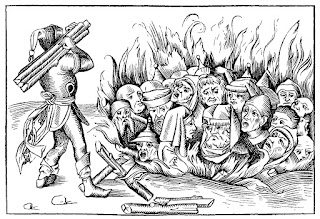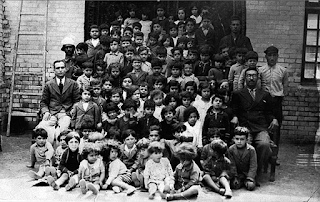Vishnevo, 1942 and Shimon Peres' Memory
Vishnevo, Poland
30 August 1942
The town of Vishneva was occupied by the USSR in 1939. Jewish institutions were closed and Jewish books were removed from the local library. However, when the Germans broke their truce with the Soviet Union in 1941 and occupied the town, things went from bad to worse. Jewish men were given forced labor, and some were murdered in the streets. The number of Jews in town was reduced to about 1,000 and they were forced into a small ghetto around the synagogue. These conditions lasted over a year.
On August 30, 1942, German soldiers moved into position around the ghetto. The Jews were gathered in the courtyard of the synagogue. Shimon Peres, the former Prime Minister and President of Israel, who was born in Vishnevo, tells the story of how the congregation was murdered:
However, it does not seem to reflect the actual events in Vishneva. Picking up again when the Jews were gathered in the courtyard of the synagogue, eye-witnesses recounted:
"Group after group they were taken to the end of the ghetto street, forced to kneel down facing a wall of a derelict building, shot in their backs and hurled into the building, many of them still alive...After the massacre, fire was set to the building." (Kehilalinks)
Cheina Rabbinovitz recalled:
"You cannot describe the sounds that came from the yard of the synagogue where the rest of the Jews were located when they heard the shots. Only a few of the Jews who were at that point still in the synagogue made an attempt to save themselves. Most of them walked to the killing field in total depression with no will to survive, like lambs to the slaughter, group after group...Each group was ordered to walk between the tables on their knees and was plowed by automatic weapons inside the house. And after the last body was thrown in there, they pushed in additional Jews who were still alive."
Yahad-In Unum quotes similar testimony, though it does recall Jews dying in a fire:
"During the liquidation of the ghetto, the Jews were locked in several houses, the Germans threw oil on the houses and set fire to them. The victims were burnt alive. Witnesses remember that the smoke lasted several days. Their bodies were then buried on the spot in mass graves by requisitioned inhabitants. Furniture and Jewish belongings were looted."
None of these accounts, nor any other account I have found, indicates that the Jews were burned to death inside the synagogue. Furthermore, other eye-witness accounts tell that the synagogue was converted into a carpentry shop. Weeks later, the surviving Jews who were hiding in the nearby woods sneaked back into town and burned the synagogue down themselves.
So where did Peres' story originate?
First of all, it is important to acknowledge that he might be right. It's possible that some Jews were killed in the synagogue. There are many similar details - the Jews were rounded up in the synagogue courtyard, the town was burned, all the Jews were killed. The only difference is the mechanism of their death. It's also possible that some Jews were killed in a similar way in nearby towns, and perhaps his grandfather was somehow involved in this.
However, it's also possible that Peres got the details wrong. He was in Palestine at the time and would have only heard the stories second-hand. It could be that he was told that his grandfather died as a martyr in the burning synagogue. As this blog has argued, this was certainly a well-known story and one that was attached to a certain amount of heroism and Jewish pride - certainly more so than execution against the wall of a random house. It could be that some well-meaning adult told the young Peres the story about his grandfather in a way to soften the blow. Alternatively, perhaps Peres heard the main details of the synagogue, the fire, and the death, and filled in the details himself. Either way, it is a strong indication of how powerful and deep-set the story of Jewish synagogue massacres is in the collective Jewish memory.
30 August 1942
The town of Vishneva was occupied by the USSR in 1939. Jewish institutions were closed and Jewish books were removed from the local library. However, when the Germans broke their truce with the Soviet Union in 1941 and occupied the town, things went from bad to worse. Jewish men were given forced labor, and some were murdered in the streets. The number of Jews in town was reduced to about 1,000 and they were forced into a small ghetto around the synagogue. These conditions lasted over a year.
On August 30, 1942, German soldiers moved into position around the ghetto. The Jews were gathered in the courtyard of the synagogue. Shimon Peres, the former Prime Minister and President of Israel, who was born in Vishnevo, tells the story of how the congregation was murdered:
"The rest arrived at the synagogue that was made of wood. Its doors were locked. They were all burned alive. That was also the last day of Rabbi Zvi Meltzer, my grandfather, my mentor. He was burned with a prayer shawl on his head. That was the last Jewish day in Vishneva. Not a single living Jew remained."As a high-profile politician, Peres told this story on many occasions, especially at Holocaust memorials. It was repeated in many eulogies after his death.
However, it does not seem to reflect the actual events in Vishneva. Picking up again when the Jews were gathered in the courtyard of the synagogue, eye-witnesses recounted:
"Group after group they were taken to the end of the ghetto street, forced to kneel down facing a wall of a derelict building, shot in their backs and hurled into the building, many of them still alive...After the massacre, fire was set to the building." (Kehilalinks)
Cheina Rabbinovitz recalled:
"You cannot describe the sounds that came from the yard of the synagogue where the rest of the Jews were located when they heard the shots. Only a few of the Jews who were at that point still in the synagogue made an attempt to save themselves. Most of them walked to the killing field in total depression with no will to survive, like lambs to the slaughter, group after group...Each group was ordered to walk between the tables on their knees and was plowed by automatic weapons inside the house. And after the last body was thrown in there, they pushed in additional Jews who were still alive."
Yahad-In Unum quotes similar testimony, though it does recall Jews dying in a fire:
"During the liquidation of the ghetto, the Jews were locked in several houses, the Germans threw oil on the houses and set fire to them. The victims were burnt alive. Witnesses remember that the smoke lasted several days. Their bodies were then buried on the spot in mass graves by requisitioned inhabitants. Furniture and Jewish belongings were looted."
None of these accounts, nor any other account I have found, indicates that the Jews were burned to death inside the synagogue. Furthermore, other eye-witness accounts tell that the synagogue was converted into a carpentry shop. Weeks later, the surviving Jews who were hiding in the nearby woods sneaked back into town and burned the synagogue down themselves.
So where did Peres' story originate?
First of all, it is important to acknowledge that he might be right. It's possible that some Jews were killed in the synagogue. There are many similar details - the Jews were rounded up in the synagogue courtyard, the town was burned, all the Jews were killed. The only difference is the mechanism of their death. It's also possible that some Jews were killed in a similar way in nearby towns, and perhaps his grandfather was somehow involved in this.
However, it's also possible that Peres got the details wrong. He was in Palestine at the time and would have only heard the stories second-hand. It could be that he was told that his grandfather died as a martyr in the burning synagogue. As this blog has argued, this was certainly a well-known story and one that was attached to a certain amount of heroism and Jewish pride - certainly more so than execution against the wall of a random house. It could be that some well-meaning adult told the young Peres the story about his grandfather in a way to soften the blow. Alternatively, perhaps Peres heard the main details of the synagogue, the fire, and the death, and filled in the details himself. Either way, it is a strong indication of how powerful and deep-set the story of Jewish synagogue massacres is in the collective Jewish memory.



Comments
Post a Comment